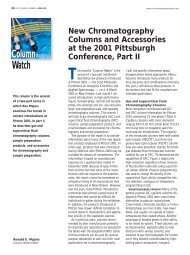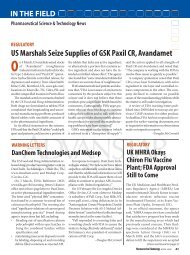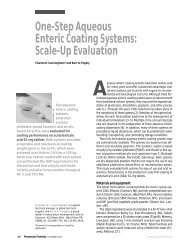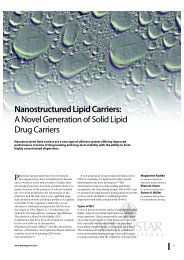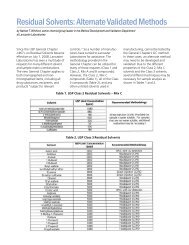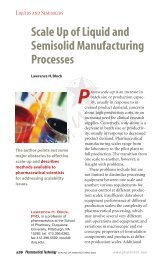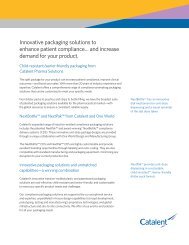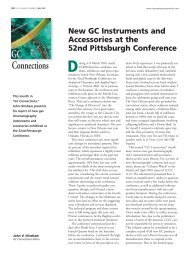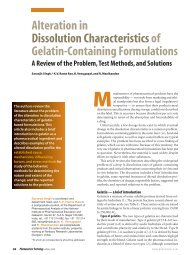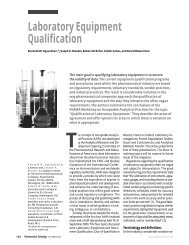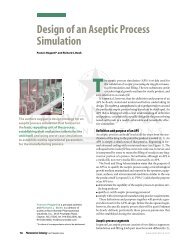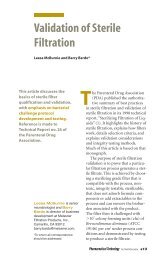Calibration of Lyophilization Pressure Gauges - Pharmaceutical ...
Calibration of Lyophilization Pressure Gauges - Pharmaceutical ...
Calibration of Lyophilization Pressure Gauges - Pharmaceutical ...
You also want an ePaper? Increase the reach of your titles
YUMPU automatically turns print PDFs into web optimized ePapers that Google loves.
<strong>Calibration</strong> <strong>of</strong><br />
<strong>Lyophilization</strong><br />
<strong>Pressure</strong> <strong>Gauges</strong><br />
Gary Osborn and Steve Hansen*<br />
ISO 9000 and<br />
FDA requirements<br />
mandate that any<br />
measurement be<br />
traceable to national<br />
standards.<br />
<strong>Calibration</strong> <strong>of</strong><br />
equipment is<br />
necessary to<br />
ensure traceability, performance,<br />
and reliability.This article explains<br />
the proper method for the in situ,<br />
on-site, or <strong>of</strong>f-site calibration <strong>of</strong><br />
lyophilizer pressure gauges and<br />
<strong>of</strong>fers some important guidelines<br />
to ensure the accuracy <strong>of</strong> a<br />
capacitance manometer.<br />
Gary Osborn is a senior applications<br />
engineer at MKS Santa Clara, 64-67 Rio<br />
Robles Avenue, San Jose, CA 95134,<br />
gary_osborn@mksinst.com. Steve<br />
Hansen is technical services director at<br />
MKS Methuen, 651 Lowell Street, Methuen,<br />
MA 01844, tel. 978.682.4567 ext. 4646,<br />
steve_hansen@mksinst.com.<br />
*To whom all correspondence should be addressed.<br />
<strong>Calibration</strong> <strong>of</strong> gauges used to measure pressure (vacuum)<br />
during freeze-drying lyophilization processes fulfills<br />
two functions: quality assurance and equipment<br />
performance. <strong>Calibration</strong> provides traceability <strong>of</strong> pressure<br />
measurements, which is necessary for compliance with<br />
ISO 9000 and FDA requirements mandating that measurements<br />
be traceable to national standards. In the United States,<br />
these standards are held by the National Institute <strong>of</strong> Standards<br />
and Technology (NIST). Such guidelines ensure that suppliers<br />
and customers are speaking the same language. With regard to<br />
performance, calibration helps improve product reliability and<br />
production time for lyophilization processes. Lyophilizer pressure<br />
affects the heat transfer from the shelf to the product,<br />
which in turn affects the drying time. A pressure that is higher<br />
than required may cause product loss, and pressure that is too<br />
low increases drying time (1). Accurate pressure measurements,<br />
obtained by periodic calibration, are required for optimal quality<br />
and productivity.<br />
Lyophilizer vacuum measurement<br />
The pressure during lyophilization generally ranges from 300<br />
to 50 mtorr. Three types <strong>of</strong> pressure measurement devices operate<br />
within this range: the McLeod mercury manometer, thermal<br />
conductivity gauges, and capacitance manometers. The<br />
McLeod gauge no longer is used because it must be manually<br />
operated and can be a source <strong>of</strong> mercury contamination. Thermal<br />
conductivity (TC) gauges are on many lyophilizers, but<br />
these sensors have the drawback that the pressure reading is<br />
determined by the rate <strong>of</strong> heat loss from a hot wire to its surrounding<br />
environment. The reading depends on the heattransfer<br />
characteristic <strong>of</strong> the vacuum medium, which depends<br />
on both pressure and gas species. Gauge manufacturers usually<br />
calibrate TC gauges relative to nitrogen. However, the most<br />
commonly used gas in lyophilization is water vapor, and under<br />
this condition a nitrogen-calibrated TC gauge will read nearly<br />
50–100% higher than the true pressure (2). To further complicate<br />
matters, during a lyophilization process the dominant<br />
gases continually change from air to water vapor.<br />
A capacitance manometer <strong>of</strong>fers the most accurate method<br />
<strong>of</strong> lyophilization pressure measurement. A capacitance manometer<br />
provides a direct-pressure measurement that is independent<br />
<strong>of</strong> the gas composition because it depends on the force <strong>of</strong> the<br />
gas on a thin diaphragm. <strong>Pressure</strong> causes the diaphragm to de-<br />
72 <strong>Pharmaceutical</strong> Technology JUNE 2002 www.pharmtech.com
flect from a zero position in which the pressure on the gauge is<br />
less than the gauge resolution. The deflection is measured by<br />
the change in capacitance between the diaphragm and adjacent<br />
electrodes. The accuracy <strong>of</strong> a capacitance manometer can be<br />
0.5% <strong>of</strong> the reading or better within a four-decade range.<br />
Heated capacitance manometers are available that prevent vapor<br />
condensation within the gauge. Ambient temperature control<br />
also reduces zero drift.<br />
Another advantage <strong>of</strong> using capacitance manometers is that<br />
the 0–10 dc volt output signal can be used for pressure control.<br />
<strong>Pressure</strong> controllers are available that use the capacitance<br />
manometer output to control a mass-flow controller or valve.<br />
The control system can be semiautomated or totally automated<br />
with the addition <strong>of</strong> a computer equipped with an A/D converter<br />
and an RS-232 link.<br />
Connection to<br />
the chamber<br />
Process gauge<br />
Bellows<br />
tubing (short)<br />
Transfer standard<br />
capacitance manometer<br />
Stable horizontal surface<br />
Figure 1: A transfer standard next to a UUT with a short connecting<br />
bellows tube and a T-fitting.<br />
Chamber<br />
Leak valve<br />
N 2<br />
Small,<br />
high-volume<br />
pump<br />
Process manometer<br />
Combination isolation/<br />
access valve<br />
V1 (pneumatic) — closed<br />
V2 (manual) — open<br />
Transfer standard<br />
capacitance manometer<br />
Figure 2: Connection <strong>of</strong> process gauge and transfer standard to an<br />
auxiliary high-vacuum pump and pressure-control system. The IDA<br />
valve stays with the tool. The auxilary pump unit with precision leak<br />
goes to the standard. The design is not optimized for controlling<br />
pressure drops.<br />
Manometer calibration<br />
<strong>Calibration</strong> is the transfer <strong>of</strong> measurement accuracy from a device<br />
<strong>of</strong> known accuracy (the standard) to a device <strong>of</strong> unknown<br />
accuracy (the unit under test, or UUT). The standard, by definition,<br />
is more accurate than the UUT and has known and documented<br />
sources <strong>of</strong> error. The operating principle and output<br />
characteristics, and hence the calibration procedures, are relatively<br />
uniform and standardized for all capacitance manometers,<br />
regardless <strong>of</strong> manufacturer.<br />
Two types <strong>of</strong> standards exist: primary and transfer. Primary<br />
standards determine a measurement in terms <strong>of</strong> fundamental<br />
properties such as mass, length, frequency, and temperature.<br />
Transfer standards, sometimes called secondary standards, generally<br />
are calibrated by a primary standard. The transfer standard<br />
then is used to calibrate a measurement device <strong>of</strong> less<br />
accuracy. Transfer standards are used because calibrating measurement<br />
devices with primary standards usually is not feasible<br />
or cost effective.<br />
Transfer standards must be traceable to national standards<br />
such as those maintained by NIST. NIST standards, in turn,<br />
are traceable to international standards defined by the International<br />
General Conference on Weight and Measures. Traceability<br />
implies that the sources <strong>of</strong> measurement error are known<br />
and documented. Documentation can be a test number, a<br />
report <strong>of</strong> calibration, or both. A calibration can be claimed as<br />
traceable to NIST standards if evidence <strong>of</strong> traceability is<br />
established, the calibration interval is not exceeded, and the<br />
calibration is performed properly.<br />
Consider a capacitance manometer used to measure the pressure<br />
in a lyophilizer. The stated accuracy <strong>of</strong> this type <strong>of</strong> manometer<br />
typically is 0.25% <strong>of</strong> reading. This manometer is calibrated<br />
with a transfer standard having an accuracy <strong>of</strong> 0.05% <strong>of</strong> reading.<br />
The transfer standard is calibrated with a dead-weight tester<br />
(a primary standard) with an accuracy <strong>of</strong> 0.01 <strong>of</strong> reading. The<br />
dead-weight tester is calibrated at NIST with a National standard<br />
accurate to 0.005% <strong>of</strong> reading. As long as all instruments<br />
in the chain have documented calibration certificates and are<br />
used within the recall date and the quality assurance documents<br />
are followed, the manometer on the lyophilizer is traceable to<br />
NIST. In reality, for cost effectiveness, this traceability trail typically<br />
is even longer with the addition <strong>of</strong> three or four additional<br />
transfer standards included in the chain. More-complete<br />
explanations <strong>of</strong> primary and transfer vacuum standards and<br />
references to the calibration literature can be found in vacuum<br />
technology texts (3).<br />
<strong>Calibration</strong> site. Vacuum gauge calibration can be performed<br />
in situ, on site, or <strong>of</strong>f site. The vacuum gauge can be calibrated<br />
in situ without removing it from the lyophilizer. Alternatively,<br />
the gauge can be removed from the lyophilizer and calibrated<br />
on site or brought to an <strong>of</strong>f-site calibration laboratory. The<br />
choice <strong>of</strong> calibration location determines the cost, the type <strong>of</strong><br />
calibration equipment required, and the turnaround time.<br />
In situ calibration. In situ calibration requires that the transfer<br />
standard be connected to the vacuum chamber by means <strong>of</strong><br />
a port located as close to the UUT as possible. This configura-<br />
<strong>Pharmaceutical</strong> Technology JUNE 2002 73
Figure 3: Self-contained portable<br />
vacuum gauge calibration system.<br />
tion is particularly important<br />
for systems that do not have<br />
positive shut<strong>of</strong>f to the vacuum<br />
pump. In such systems,<br />
the internal lyophilizer volumes<br />
closest to the vacuum<br />
pumps will be significantly<br />
smaller than those near the<br />
gas inlet. If the calibration<br />
port cannot be adjacent to the<br />
measurement device port, it<br />
should be placed the same<br />
distance (in terms <strong>of</strong> vacuum<br />
conductance) from the inlet<br />
gas and vacuum pump as the<br />
UUT.<br />
Because the pressure for the<br />
lyophilization process is less than 1 torr, gas flow is in the transition-flow<br />
regime. This means that vacuum conductance plays<br />
a large role in accurate pressure readings. For this reason, the<br />
line lengths between the standard and the UUT should be as<br />
short and as large in diameter as possible. The optimum location<br />
would have the standard mounted on a T-connection next<br />
to the UUT as shown in Figure 1. In many situations, this design<br />
is not practical and compromises must be made. Because<br />
the conductance <strong>of</strong> a short tube is directly proportional to its<br />
length but proportional to the square <strong>of</strong> its diameter, increasing<br />
the diameter <strong>of</strong> a connection tubing relative to the standard is<br />
preferred over decreasing its length. One must allow sufficient<br />
time for equilibrium to be reached and the proper pressures to<br />
be read by the standard and the UUT. The time that is required<br />
depends upon the vacuum conductances in the system.<br />
An in situ calibration requires a transfer standard and readout.<br />
High-accuracy, temperature-controlled capacitance<br />
manometers are the typical accepted transfer standards. The<br />
minimum recommended warm-up time for these measurement<br />
standards is four hours.<br />
In situ calibration requires that the lyophilizer vacuum pumps<br />
and pressure controller establish the pressure setpoints. Unfortunately<br />
a lyophilizer vacuum pump will not produce a low<br />
enough vacuum to properly zero capacitance manometers. A<br />
1-torr full-scale manometer has a recommended zeroing pressure<br />
<strong>of</strong> 1 10 5 torr, and a typical mechanical pump has a base<br />
pressure <strong>of</strong> 1 10 3 torr.Ifa leak detector is available, it may<br />
be attached as an auxiliary pump to establish a low base pressure.<br />
If a high-vacuum pumping station is available at an alternative<br />
location, it can be used to zero the standard, which<br />
then can be valved <strong>of</strong>f and moved to the lyophilizer. The UUT<br />
can be adjusted to read the same as the standard at the lowest<br />
attainable pressure.<br />
The preferred calibration setup is a pressure-controlled highvacuum<br />
pumping system with the UUT isolated from the system<br />
(see Figure 2). The valve between the UUT and the chamber<br />
allows the isolation <strong>of</strong> the chamber and the UUT yet still<br />
allows connection to the calibration system.<br />
On-site calibration. With this method the UUT is removed from<br />
the lyophilizer and connected to a calibration manifold, thereby<br />
eliminating conductance and dynamic effects. This method is<br />
recommended if a long vacuum line is required to connect the<br />
standard to the lyophilizer. On-site calibration requires a highvacuum<br />
pumping system, a standard, and a pressure-control<br />
system. Using this method, one can calibrate quickly the UUT<br />
and replace it on the lyophilizer without the need for a spare<br />
replacement gauge. Figure 3 shows a portable, self-contained<br />
vacuum gauge calibration system. This system also can be used<br />
for in situ calibration.<br />
Off-site calibration. To conduct <strong>of</strong>f-site calibration, one removes<br />
the measurement device and sends it to a calibration laboratory,<br />
which may or may not be located at the facility. This calibration<br />
requires a spare calibrated gauge to replace the gauge sent out<br />
for recalibration. The advantages <strong>of</strong> this method are that calibration<br />
equipment need not be kept on the production floor<br />
and that downtime is minimal when spares are used.<br />
<strong>Calibration</strong> guidelines<br />
A few important guidelines should be followed to ensure accurate<br />
calibration <strong>of</strong> a capacitance manometer.<br />
To achieve temperature stability, the manometer should be operated<br />
for four hours after power has been applied. The manometers<br />
also must be at normal operating temperatures. This recommendation<br />
applies to the standards as well as to the UUT.<br />
The capacitance manometer must be zeroed properly before<br />
a valid calibration can be performed. Proper zeroing is<br />
critical. One should keep in mind that capacitance manometers<br />
measure absolute pressure referenced to a “perfect” vacuum.<br />
The standards also must be zeroed to obtain a common<br />
reference point for comparing the reading <strong>of</strong> the standard with<br />
that <strong>of</strong> the UUT. The manometer must be zeroed at a pressure<br />
low enough to exceed the resolution <strong>of</strong> the manometer. A recommended<br />
zeroing pressure is four decades below full scale.<br />
Therefore, a 1-torr, full-scale manometer requires a pressure<br />
<strong>of</strong> 1 10 4 torr for proper zeroing. An ionization gauge should<br />
be used to verify a low zeroing pressure.<br />
Six data points usually are adequate to ensure that a process<br />
capacitance manometer is within calibration specification. Recommended<br />
calibration points are at 10, 20, 40, 60, 80, and 100%<br />
<strong>of</strong> full-scale reading.<br />
If the capacitance manometer has a full-scale pressure <strong>of</strong><br />
1 torr or lower, a correction for thermal transpiration is required<br />
for maximum accuracy. Thermal transpiration errors<br />
result when the pressure is in the molecular-flow regime and<br />
a tube connects two volumes at different temperatures. The<br />
error in pressure is proportional to the square root <strong>of</strong> the<br />
ratio <strong>of</strong> the absolute temperatures <strong>of</strong> the two connecting<br />
regions (4). Thermal transpiration errors decrease as the pressure<br />
increases and become negligible as the pressure<br />
approaches 1 torr. The simplest way to avoid thermal transpiration<br />
errors is to ensure that the standard, the UUT, and<br />
the connecting plumbing all are at the same temperature. If<br />
required, tables <strong>of</strong> correction factors can be obtained from<br />
the manufacturer <strong>of</strong> the calibration equipment.<br />
<strong>Calibration</strong> and zeroing intervals. Establishing appropriate calibration<br />
intervals requires the collection <strong>of</strong> historical data. The<br />
lyophilization process and the treatment <strong>of</strong> the manometer play<br />
74 <strong>Pharmaceutical</strong> Technology JUNE 2002 www.pharmtech.com
a large role in the determination <strong>of</strong> how <strong>of</strong>ten the manometer<br />
requires zeroing and calibration. For example, if a 1-torr, fullscale<br />
manometer routinely is exposed to atmospheric pressure,<br />
its zero should be checked more frequently than the zero <strong>of</strong> a<br />
manometer that is isolated with a positive shut-<strong>of</strong>f valve whenever<br />
the process chamber is brought up to atmosphere. An isolated<br />
manometer also will require less frequent calibration. A<br />
manometer exposed to a harsh environment must be recalibrated<br />
more <strong>of</strong>ten than one that is only exposed to benign gases.<br />
Steam sterilization <strong>of</strong> a lyophilization unit, typically performed<br />
at pressures <strong>of</strong> 35 psia, will require an un-isolated<br />
manometer to be checked more frequently. Initially, one should<br />
start with zeroing intervals <strong>of</strong> once per month and calibration<br />
intervals <strong>of</strong> once every 2–3 months for a steam-sterilized<br />
manometer. The calibration intervals <strong>of</strong> manometers not exposed<br />
to steam sterilization may be extended to beyond three<br />
months.<br />
Manometers that are isolated from atmospheric pressure<br />
may have quite long intervals between zeroing and calibration<br />
requirements. For these devices, one should maintain a history<br />
<strong>of</strong> in- and out-<strong>of</strong>-tolerance conditions and adjust the interval<br />
to maximize the time between calibrations. A good goal is to<br />
establish a calibration interval in which 70% <strong>of</strong> the calibrations<br />
are within specifications. This specification may not have<br />
to be that <strong>of</strong> the manometer manufacturer, but the specification<br />
should be such that the lyophilization process is consistent<br />
and reliable. Statistical studies have indicated that a 70%<br />
in-tolerance goal is an optimum trade-<strong>of</strong>f for system performance<br />
and cost effectiveness for calibration. The ultimate goal<br />
when establishing calibration intervals is to ensure process<br />
reliability and yield at minimum cost.<br />
Conclusion<br />
<strong>Calibration</strong> <strong>of</strong> lyophilization process pressure measurements is<br />
necessary to meet ISO 9000 and FDA requirements. <strong>Calibration</strong><br />
<strong>of</strong> pressure measurement devices also ensures optimum<br />
lyophilization and increased batch reliability and yield. The development<br />
and management <strong>of</strong> a calibration program is neither<br />
trivial nor inexpensive, and some thought must be put into<br />
the determination <strong>of</strong> the best and most economical approach<br />
for calibration. The various calibration approaches — in situ,<br />
on site, and <strong>of</strong>f site — have individual setup and program maintenance<br />
costs. <strong>Calibration</strong> approaches can be combined to establish<br />
the optimum calibration program. When established<br />
correctly, a calibration program can meet all the quality assurance<br />
requirements and be cost effective.<br />
CALL FOR PAPERS<br />
Have you confronted a difficult outsourcing<br />
challenge lately? Have you solved a formidable<br />
problem for your contract research/<br />
manufacturing organization?<br />
If so, we want to hear from you. <strong>Pharmaceutical</strong><br />
Technology is interested in your contract services<br />
experiences involving issues such as<br />
● technology transfers<br />
● intellectual property rights<br />
● new technologies<br />
● stability testing<br />
● formulation development.<br />
Send us your manuscripts on all aspects <strong>of</strong> contract<br />
services, including but not limited to case histories,<br />
technical notes, position papers, reviews, and reports.<br />
We want to know what complications you’ve<br />
encountered, how you responded to them, what you<br />
wish you had done differently — in short, what it’s like<br />
to be a specialist in an ever-expanding, highly technical<br />
industry. Tell us about it!<br />
For more information, please contact:<br />
References<br />
1. L. Menyhart,“<strong>Lyophilization</strong>: Freeze-Drying, A Downstream Process,”<br />
www.rpi.edu/dept/chem-eng/Biotech-Environ/LYO/index.html.<br />
2. J.F. O’Hanlon, A User’s Guide to Vacuum Technology (Wiley-Interscience,<br />
New York, NY, 2d ed., 1989), p. 83 ff.<br />
3. For example, see Handbook <strong>of</strong> Vacuum Science and Technology, D.M.<br />
H<strong>of</strong>fman, B. Singh, and J.H. Thomas, Eds. (Academic Press, New York,<br />
NY, 1998), pp. 286–287.<br />
4. P.A. Redhead, J.P. Hobson, and E.V. Kornelson, The Physical Basis <strong>of</strong><br />
Ultrahigh Vacuum (American Institute <strong>of</strong> Physics, Woodbury, NY,<br />
1993), pp. 284–287. PT<br />
NORTH AMERICA<br />
Ronelle Russell, Associate Editor<br />
859 Willamette St.<br />
Eugene, OR 97401-6806<br />
tel. 541.984.5332<br />
e-mail: rrussell@advanstar.com<br />
¨<br />
ARTVILLE, INC.<br />
<strong>Pharmaceutical</strong> Technology JUNE 2002 75



